Super Mario Sunshine Updated Preview
Read three different opinions about this very different Mario game.
Super Mario Sunshine is one of most anticipated games coming to the GameCube this year. The absence of a Mario game at the GameCube's launch last year left fans of Nintendo's rotund but spry mascot feeling incomplete--the little guy had been a fixture at nearly every Nintendo hardware release. Thankfully, the wait for Mario's next adventure ended in Japan last month and will end here on August 26. Not content to wait until then, we set out to import a copy of the game as soon as it hit Japan. We were treated to an extra dose of anticipation thanks to the magic, or lack thereof, of the postal system. In retrospect, we might have had better luck if we'd tried another means of delivery--a burro or a homing pigeon, for example--but we finally scored a copy and have been dutifully logging in time with the latest installment in the granddaddy of platforming series.
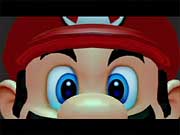
Mario's GameCube incarnation serves up an experience that is decidedly different from what's come before. The game definitely meets the core expectations any gamer would have of a Mario game, and it also throws in some things we never expected. Unique, addictive gameplay wrapped in eye-popping graphics that make impressive use of the GameCube hardware make Mario Sunshine a standout title for Nintendo's fledgling system. This year's Mario also features a much stronger story element than previous Mario games, with the obvious exceptions of Super Mario RPG on the SNES and Paper Mario on the Nintendo 64. You'll be drawn into the curious tale through the use of real-time cutscenes and CG sequences complete with voice. It's an interesting mix that adds a new dynamic to the Mario formula we've all grown accustomed to.
But does it work? Is this the Mario experience everyone wanted? It's hard to say. We've clocked in quite a bit of time with the game and can certainly attest to its quality. But we're reserving judgment on its classic status until we get our hands on the US build of the game later this month. Until then, check out these varying impressions of the game from different members of our editorial staff. Ricardo chimes in first...
Ricardo Torres
Associate Editor
Like most every other gamer who grew up with the Mario franchise, I've looked forward to every new installment in the series. Shigeru Miyamoto and his teams have managed to take each new Mario game in a unique and groundbreaking direction. As the games have evolved along with the hardware they've been released on, we've been treated to some of the finest 2D and 3D platforming around. Not only has the series provided gamers with some truly memorable moments, but it has also established a blueprint that has set the tone for platforming since. Mario 64 was a pivotal moment in the evolution of 3D gaming thanks to the game's incredible design and revolutionary gameplay. The success of the series, especially of Mario 64, has caused expectations for Super Mario Sunshine to shoot through the roof. Most folks expect nothing less than another gameplay revolution along the lines of Mario 64. Even I have to admit that managing my expectations has taken some serious work because of Nintendo's stunning track record. So did it meet my expectations? Yes and no.
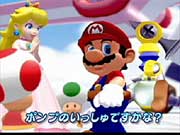
I'll be honest, I came to this party for the gameplay. The most appealing aspect of the series, for me, has always been its gameplay. The best Mario games have always offered gameplay that's deceptively simple in appearance and execution, but a challenge to master. It's that extra layer of polish the Mario games have always had that's kept me hooked for months after their release. In that respect, Super Mario Sunshine comes fully loaded and then some. Packing his full complement of moves from Mario 64 and adding a new batch to the mix, Mario's still got "it" as far as I'm concerned. His new water cannon adds a new dynamic to the gameplay, and it's going to require you to master a new batch of skills, which is fine by me.
More From Ricardo
Getting accustomed to Mario's new moves is a bit more challenging than you might expect. Whereas earlier Mario games eased you into things, Super Mario Sunshine pretty much says, "You're a big boy or girl, get to it!" and flings you headfirst into the action. Once the initial shock wears off--somewhere around the time when you defeat the first piranha plant--you'll probably find it's not as daunting an experience as it initially seemed. That's not to say you won't have to work to master everything. You will. But mastering the many uses of the pump is a fun challenge, as is working out your old-school platform skills on levels where Mario finds himself pumpless and faced with a trail of platforms leading to a shine.
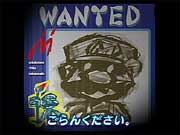
Probably the biggest challenge in mastering Mario's gameplay for most players will involve the camera. You'll definitely have to spend some time getting accustomed to the new camera system. Whether that relationship is a positive one or a love-hate one will depend on the individual. Personally, I run the gamut--there were times when it all good between me and the camera and others when I was cursing like a sailor. This may be unsettling for players hoping for a rehash of Mario 64's impressive camera system, but Sunshine's gameplay and environments have a new set of needs. I still haven't decided how I feel about the camera still, and I'm reserving final judgment until I finish the domestic game. I will say I sure wouldn't complain if the camera were tightened up before the game hit the States.
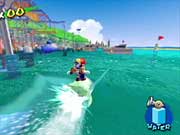
I could go on at length about Mario Sunshine's gameplay, but that wouldn't be painting the whole picture. Like I said, I came here for the gameplay, but I'm not about to gloss over the game's graphics, which are an impressive embodiment of Nintendo's assertion that it's not the number of polygons that you push but what you do with them. If you stripped away the special effects being used on the polygons on Mario's model--his "makeup," if you will--you wouldn't find a high-poly creation. This holds true for most of the game, and you know something? I couldn't care less. Rather than waste polygons on tarting Mario and everything in the game up to look photo-realistic, the team takes a "less is more" approach, and it suits the game perfectly. How much more lifelike do we want Mario to look, anyway? This is a short, tubby plumber, not the cast of Dead or Alive Xtreme Beach Volleyball, after all. I could live a full life and never see whatever jiggles a high poly makeover would give him, thank you very much. The one showpiece of the game is its water. Featuring gorgeous gradations of color and texture along with smooth animation, the water in Super Mario Sunshine is quite a sight. Granted, the game has some rather unfortunate textures, occasional uses of blocky geometry, and spooky instances of slowdown, but nothing that mars the overall visual experience.
So did Super Mario Sunshine meet my expectations or not? For the most part, I'd say it did. The gameplay is there, and the graphics are icing on the cake. Does it offer the same kind of genre-defining experience its cartridge-based predecessor did? No. But I really don't see how it could have. The 3D platforming genre has evolved quite a bit since Mario 64--due in no small part to that game's contributions--and it would be very hard for any game to have the same kind of impact. At this point, the best thing to hope for are some cool refinements and additions to the gameplay conventions of the genre. In that respect, Super Mario Sunshine succeeds, offering its own unique gameplay twists to the platformer canon, and it stands as a game any fan of platformers should check out.
Giancarlo Varanini
Associate Editor
Super Mario Sunshine is a difficult game to describe, not because it does something incredibly innovative, but rather because it blends so many different gameplay mechanics together. The game contains many of the basic platforming elements of Super Mario 64 mixed in with a little of Luigi's Mansion and even some Pilotwings. It all adds up to an experience that isn't substantially different from Super Mario 64, but you will undoubtedly be surprised by the water cannon and how it works in the game.
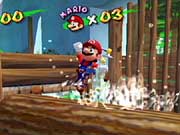
It surprised me simply because I didn't know what to expect from Super Mario Sunshine. Before I'd even had the opportunity to see it in person, the water cannon on Mario's back seemed like nothing more than a gimmick--a device he would use to clean up paint in the environment while performing his standard platforming duties. But in fact, the water cannon is a crucial part of the gameplay, as it enhances Mario's preexisting platforming skills. Mario can use the water cannon to hover, which can be helpful for getting to ledges that would otherwise be out of reach. He can even use it to propel himself across the water while standing on an oversized lily pad, or create a Slip 'n Slide. More importantly, the water cannon is now Mario's primary method of attack--gone are the punches and kicks of Super Mario 64, though the butt-stomp does come into play.
It can take a little while to become adjusted to Mario's new abilities. Controlling the water pack while in flight is quite similar to controlling the jetpack portion of Pilotwings. Every time Mario has to land on an obscenely small platform, my brain immediately switches into Pilotwings mode and the platform becomes a target with different point values marked across it. You have to compensate for momentum so Mario doesn't overshoot the target, and you need to be aware of the fact that the water cannon eventually loses pressure, so you simply can't hover all day. It takes some time to get used to, especially if you're accustomed to Mario dropping sharply after a jump, but you should have no problem getting a feel for how to maneuver around within an hour. In all honesty, most of the difficulty in moving Mario around stems from the game's camera.
Super Mario Sunshine's camera usually stays at a nice distance behind Mario, enabling you to see everything that you need to see. You can rotate the camera around in every direction by tapping on the GameCube C stick, and you can switch it back into the default behind-Mario view by pressing the L trigger. It all works pretty well, until Mario gets into a confined space. All of a sudden, the camera drops behind a wall, completely blocking your view of Mario and the environment, and the real kicker is that sometimes you can't rotate the camera out of the wall. Instead, you have to nudge Mario just enough that the camera is able to break out of its invisible prison. Naturally, in areas where there aren't any sharp drops a foot in front of you, it's not a big deal, but when you're standing on an incredibly small platform with very little room to navigate, it becomes a problem.
The levels are populated by more enemies and are generally larger than those found in Super Mario 64, but then again, they have to be in order to compensate for Mario's water cannon and its two attachments, which allow Mario to rocket jump or speed across the ground. One particularly cool level is Ricco Harbor, which is filled boats, submarines, and locals floating around in inner tubes. This level essentially puts all of Mario's skills to the test--you'll have hover, climb around on chain-link fence, make jumps to narrow walkways, attack enemies with the cannon, and swim. It's also home to one of the more interesting boss battles, in which Mario has to take on a gigantic squid that sprays sludge and flaps his tentacles around. But perhaps the most interesting boss battle is the one that involves a familiar enemy from Super Mario World, only this enemy is about 20 times bigger than it was before.
Then there's Yoshi. It's understandable that Nintendo would include Mario's dinosaur friend in his latest adventure, seeing as the greatest motivation for finding all the stars in Super Mario 64 was to see Yoshi in all his 3D glory. But what's surprising about Yoshi is that Nintendo has now given him the ability to vomit fruit juice all over the landscape. You'll really only use the juice to get into areas that are blocked by a weird yellow wall, but it's still fun to see Yoshi spray recycled juice on unsuspecting locals.
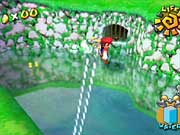
Like many of the games in the series before it, Super Mario Sunshine is an incredibly colorful game, and that's probably one of its most impressive visual aspects. Sure, there are some really well done reflective surfaces (particularly in the level that has enormous reflective mirrors surrounding a lighthouse), heat waves, and water effects, but the sheer vibrancy of the game is what enhances all those effects. That being said, the game is not exactly pushing a huge number of polygons. With the exception of Mario and a few others, most of the characters and environments in the game are simplistic in design. There are quite a few sharp edges and textures that don't exactly speak well to the GameCube texture-compression capabilities, but the game still looks incredibly nice regardless.
Super Mario Sunshine is finally here, and while it may not live up to the ridiculously high expectations set by its predecessor, it's still an enjoyable game that any platforming fan will immediately latch onto.
Amer Ajami
Senior Editor
Everything that Miyamoto touches turns to gold. Well, not literally, of course, but the man has been making outstanding video games for the better part of 20 years without taking a single break, and without fail, all his creations have been widely regarded as instant classics. But the Midas touch is as much a blessing as it is a curse, because as memorable as all Miyamoto's games are, the pressure to follow up on his previous work with something that's that much better must be crushing. With the recent release of Super Mario Sunshine in Japan, the burning question on my mind was, "Is it better than Super Mario 64?" Having played the game for a while now, all I can say is that that's the wrong question to ask.
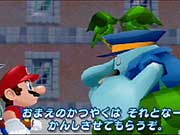
Why? Because Sunshine doesn't follow the same natural progression that Super Mario Brothers 3, for example, took to become Super Mario World. Or Super Mario Kart to Mario Kart 64. Or any of the sequels in Miyamto's popular franchises, for that matter. Put simply, Super Mario Sunshine isn't a sequel to Super Mario 64, and anyone expecting it to be will be sorely disappointed. In fact, about the only things the two games have in common are the portly plumber and the fact that they both take place in a rich, well-designed 3D world.
The differences between the two? Where to start? The most noticeable distinction of Sunshine is the fact that it doesn't take place in the Mushroom Kingdom, a world that has been called home by nearly every single Mario game except Super Mario Brothers 2. As such, most of the characters and enemies that you'll run into are brand new. Sure, the wiggler from Super Mario World and the franchise's piranha plants can be found in certain areas of the world, but for the most part, Sunshine is devoid of such Mario mainstays as koopa troopas, goombas, and bullet bills. One of the most notable aspects of Super Mario 64 was interacting with the Mushroom Kingdom in a completely 3D environment. Instead of building on that experience, Sunshine avoids it altogether. Furthermore, Sunshine's primary gameplay mechanic focuses around Mario's water pack, a contraption that has numerous functions, including a hose, a hoverpack, and a portable propeller, of sorts. Head jumps and butt-stomps are still quite useful against enemies, but this new water pack adds a little bit of variety to Mario's tried and true collection of moves.
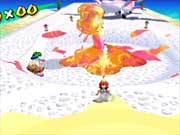
By now you might be feeling hints of disappointment. You shouldn't. Sunshine's world is spectacular as Mario 64's ever was. In fact, from a purely technical perspective, Super Mario Sunshine and its world are quite impressive. The controls, for example, are a lot tighter than Super Mario 64's, and in fact, it's even more precise than most of the traditional 3D platform games that have been released since, including particularly notable ones like Jak & Daxter. Gauging the distance between gaps and timing Mario's jumps never involves any guesswork. You can exert just the right amount of control over Mario while he's jumping through the air, and the water pack acts as a safety net, since you can use it to correct your trajectory if you do manage to overshoot a ledge or a cliff. But this tight control scheme is necessary, because Sunshine is a pure platformer through and through. Whereas Super Mario 64 blended elements of puzzle solving and exploration with a little bit of the classic platform conventions of timing, jumping, and what have you, Super Mario Sunshine is simply just one, large platform game, and it makes no attempt at hiding that fact. Take Ricco Harbor, for example. That level is completely made up of walls, overhangs, catwalks, cranes, and moving ledges, and Mario isn't able to take two steps without having to perform some sort of dexterous feat, the likes of which would make the Ringling Brothers proud. In fact, it's safe to say that Super Mario Sunshine is downright hard. The game's reliance on platform-style gameplay elements means that you'll have to master every last one of Mario's moves and water pack functions. What's more, some levels remove your water pack altogether, which makes attempting Mario's moves a lot more challenging, though never more frustrating. It's a little intimidating at first, but the challenge will always keep you coming back.
This game is certainly not what I was expecting. I wanted to do battle with Bowser while stomping on koopas and chasing fire flowers. Sunshine won't let you do any of that. But after having invested some time in it, I'm actually excited about what it will let me do, and that's discover a completely unfamiliar Mario world using the most familiar video game character in history.
Got a news tip or want to contact us directly? Email news@gamespot.com
Join the conversation